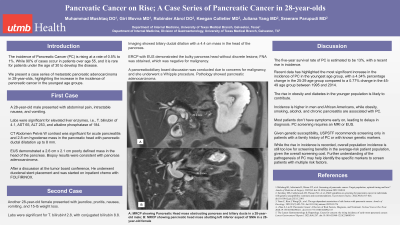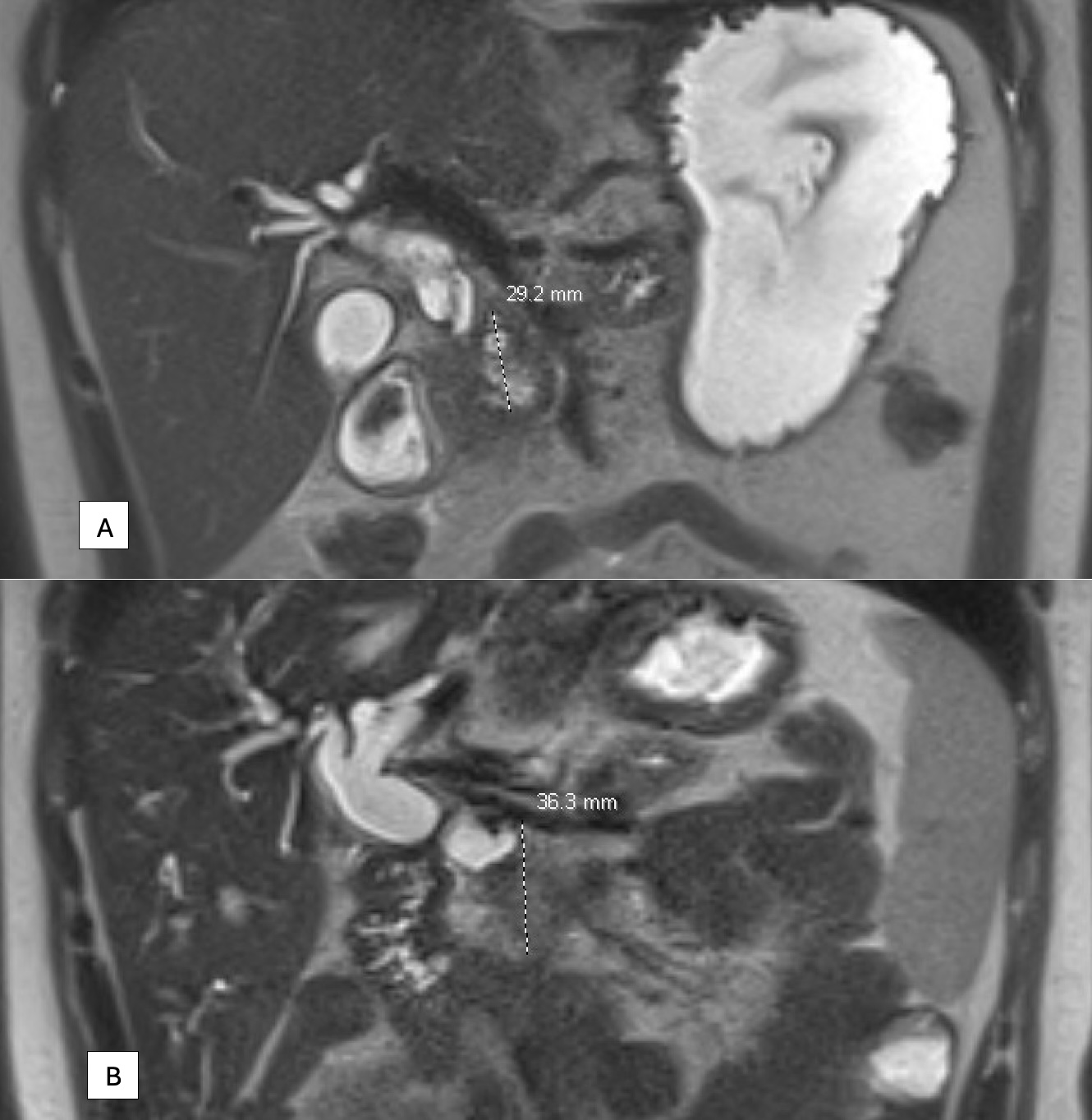Monday Poster Session
Category: Biliary/Pancreas
P1867 - Pancreatic Cancer on Rise: A Case Series of Pancreatic Cancer in 28-Year-Olds
Monday, October 28, 2024
10:30 AM - 4:00 PM ET
Location: Exhibit Hall E

Has Audio

Muhammad Mushtaq, DO
University of Texas Medical Branch
Galveston, TX
Presenting Author(s)
Muhammad Mushtaq, DO, Giri Movva, MD, Robinder Abrol, DO, Keegan Colletier, MD, Juliana Yang, MD, Sreeram Parupudi, MD
University of Texas Medical Branch, Galveston, TX
Introduction: The incidence of Pancreatic Cancer (PC) is rising at a rate of 0.5% to 1%. While 90% of cases occur in patients over age 55, and disease under the age of 30 is rare. We present a case series of PC in two 28-year-olds, highlighting the increase in the incidence of pancreatic cancer in the younger population.
Case Description/Methods: A 28-year-old male presented with abdominal pain, nausea, and vomiting. Labs were significant for T. bilirubin of 4. CT Abdomen was significant for pancreatitis with a 2.8 cm hypodense mass in the pancreatic head with pancreatic ductal dilatation up to 8 mm. He underwent ERCP with sphincterotomy, stent placement and later outpatient EUS with biopsy, which was consistent with pancreas adenocarcinoma. Interim, developed post-ERCP pancreatitis, MRI showed increased mass size, encasement of SMV, SMA and duodenum with dilated stomach, suspicious for early partial obstruction. Post-tumor board discussion, duodenal stenting and inpatient chemo were initiated.
Another 28-year-old female presented with jaundice, pruritis, nausea, vomiting, and 15-lb weight loss. Labs were significant for T. bilirubin12.8, with conjugated bilirubin 8.8. Imaging showed biliary ductal dilation with a 4.4 cm mass in the head of the pancreas. ERCP with EUS demonstrated the bulky pancreas head without discrete lesions; FNA was obtained, which was negative for malignancy. A pancreaticobiliary board discussion was conducted due to concerns for malignancy, and she underwent a Whipple procedure. Pathology showed pancreatic adenocarcinoma. The patient was referred to oncology to start adjunctive chemotherapy.
Discussion: The five-year survival rate of PC is estimated to be 13%, with a rise in incidence. Most patients don’t have symptoms early on, leading to diagnosis delays. PC screening requires an MRI or EUS. USPSTF recommends screening only in patients with a family history of PC or with known genetic markers, given genetic susceptibility. Recent data showed a 4.34% percentage increase in the age group 25-29 years compared to a 0.77% change in the age group 45-49 between 1995 and 2014 for PC incidence. The rise in obesity and diabetes in the younger population is likely to contribute. Besides the rise in incidence, the overall incidence remains low for screening benefits in the average-risk patient population, given the screening cost. Further understanding of the pathogenesis of PC may help identify the specific markers to screen patients with multiple risk factors.

Disclosures:
Muhammad Mushtaq, DO, Giri Movva, MD, Robinder Abrol, DO, Keegan Colletier, MD, Juliana Yang, MD, Sreeram Parupudi, MD. P1867 - Pancreatic Cancer on Rise: A Case Series of Pancreatic Cancer in 28-Year-Olds, ACG 2024 Annual Scientific Meeting Abstracts. Philadelphia, PA: American College of Gastroenterology.
University of Texas Medical Branch, Galveston, TX
Introduction: The incidence of Pancreatic Cancer (PC) is rising at a rate of 0.5% to 1%. While 90% of cases occur in patients over age 55, and disease under the age of 30 is rare. We present a case series of PC in two 28-year-olds, highlighting the increase in the incidence of pancreatic cancer in the younger population.
Case Description/Methods: A 28-year-old male presented with abdominal pain, nausea, and vomiting. Labs were significant for T. bilirubin of 4. CT Abdomen was significant for pancreatitis with a 2.8 cm hypodense mass in the pancreatic head with pancreatic ductal dilatation up to 8 mm. He underwent ERCP with sphincterotomy, stent placement and later outpatient EUS with biopsy, which was consistent with pancreas adenocarcinoma. Interim, developed post-ERCP pancreatitis, MRI showed increased mass size, encasement of SMV, SMA and duodenum with dilated stomach, suspicious for early partial obstruction. Post-tumor board discussion, duodenal stenting and inpatient chemo were initiated.
Another 28-year-old female presented with jaundice, pruritis, nausea, vomiting, and 15-lb weight loss. Labs were significant for T. bilirubin12.8, with conjugated bilirubin 8.8. Imaging showed biliary ductal dilation with a 4.4 cm mass in the head of the pancreas. ERCP with EUS demonstrated the bulky pancreas head without discrete lesions; FNA was obtained, which was negative for malignancy. A pancreaticobiliary board discussion was conducted due to concerns for malignancy, and she underwent a Whipple procedure. Pathology showed pancreatic adenocarcinoma. The patient was referred to oncology to start adjunctive chemotherapy.
Discussion: The five-year survival rate of PC is estimated to be 13%, with a rise in incidence. Most patients don’t have symptoms early on, leading to diagnosis delays. PC screening requires an MRI or EUS. USPSTF recommends screening only in patients with a family history of PC or with known genetic markers, given genetic susceptibility. Recent data showed a 4.34% percentage increase in the age group 25-29 years compared to a 0.77% change in the age group 45-49 between 1995 and 2014 for PC incidence. The rise in obesity and diabetes in the younger population is likely to contribute. Besides the rise in incidence, the overall incidence remains low for screening benefits in the average-risk patient population, given the screening cost. Further understanding of the pathogenesis of PC may help identify the specific markers to screen patients with multiple risk factors.

Figure: A: MRCP showing Pancreatic Head mass obstructing pancreas and biliary ducts in 28-year-old male; B: MRCP showing pancreatic head mass abutting left inferior aspect of SMA in a 28-year-old female
Disclosures:
Muhammad Mushtaq indicated no relevant financial relationships.
Giri Movva indicated no relevant financial relationships.
Robinder Abrol indicated no relevant financial relationships.
Keegan Colletier indicated no relevant financial relationships.
Juliana Yang indicated no relevant financial relationships.
Sreeram Parupudi indicated no relevant financial relationships.
Muhammad Mushtaq, DO, Giri Movva, MD, Robinder Abrol, DO, Keegan Colletier, MD, Juliana Yang, MD, Sreeram Parupudi, MD. P1867 - Pancreatic Cancer on Rise: A Case Series of Pancreatic Cancer in 28-Year-Olds, ACG 2024 Annual Scientific Meeting Abstracts. Philadelphia, PA: American College of Gastroenterology.
